It Was the "Sap"
- Thread starter Briar Lee
- Start date
You are using an out of date browser. It may not display this or other websites correctly.
You should upgrade or use an alternative browser.
You should upgrade or use an alternative browser.
SmokingPipes.com Updates
Watch for Updates Twice a Week
- Status
- Not open for further replies.
@Briar Lee you hold way too much weight in the wood and not enough in the stems for smokeability. The stems, slots, tenon, etc all make a big difference.
The sap inside the burls of the heather shrubs that grow around the Mediterranean tastes the best.
If you like the sap taste from Algerian briar it has lots of it.
he got the tightest, oldest burls full of good tasting sap the makers had
Tannins are bad sap.
But for example, red cedar is blatantly aromatic. Heather burl briar is much less so, but there’s still “good sap” in the briar so long as the pipe hasn’t been smoked to death and saturated with tars.
The amount of “good sap” in a piece of briar depends on how many lines of what was bark grew on the burl, the tighter the tastier.
There are good saps, and bad saps
There was lot of reddish “sap” in Algerian briar.
It was a problem for the makers of the very highest dollar pipes.
Can you please cite your sources for these pieces of information? Wondering what magnificent book/publication you are reading that has so much sap detail. Thanks!
This is very true! But, I would make the point that “all else being the same” the wood is the only variable that nature controls, so discussion of the differences it may present is certainly a valid topic of discussion.@Briar Lee you hold way too much weight in the wood and not enough in the stems for smokeability. The stems, slots, tenon, etc all make a big difference.
How scientific and reliable that discussion may be, is of course, debatable
Its not all else being the same. The stems on those Marxmans look terribleThis is very true! But, I would make the point that “all else being the same” the wood is the only variable that nature controls, so discussion of the differences it may present is certainly a valid topic of discussion.
How scientific and reliable that discussion may be, is of course, debatable
Yes, on that you are correct, in the anecdotal examples used in this thread it goes to shit, I was speaking hypothetically about the general topic, not lending validity to the way it’s been presented.Its not all else being the same. The stems on those Marxmans look terrible
Sorry for the confusion.
Good illustration. Fine piece of workmanship. But no where near 100 to the inch, which prompted my first question. If there is such a piece of briar, I don't see how anyone could count that fine, unless raw wood and under a microscope.GROWTH RINGS!!!!!
Hahaha agreedGood illustration. Fine piece of workmanship. But no where near 100 to the inch, which prompted my first question. If there is such a piece of briar, I don't see how anyone could count that fine, unless raw wood and under a microscope.
Forgive me but I don't see any growth rings in that pipe; birdseye and Xylam (capillaries) yes but no growth rings.
How Pipes Get Their Grain | A Closer Look at the Heath Tree Burl
Learn more about the grain of the heath tree burl and how it affects the look of briar pipes.www.smokingpipes.com
They may not be growth rings but they are lines that ancient Algerian briar had.
It was utterly hell to try and make a perfect, straight or flame grain or birdseye Algerian.
Instead of grain a lot of it only had those lines, it was full of pits, soft as butter, they cross cut most of it.
Here’s some more of whatever those lines were.
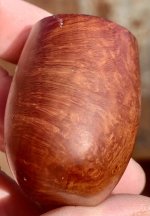
And something is inside thaf leeches out.
Two smokes
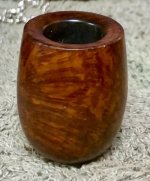
Last edited:
That is just cross grain. Aka straight grain sideways.Here’s some more of whatever those lines were.
Where did you read this?It was utterly hell to try and make a perfect, straight or flame grain or birdseye Algerian.
This thing with sap is pretty sappy if you ask me. There is absolutely no evidence that briar sap from different regions of briar makes any bit of difference in how a pipe smokes. If it does, cite previous articles on the subject.
This thing with sap is pretty sappy if you ask me. There is absolutely no evidence that briar sap from different regions of briar makes any bit of difference in how a pipe smokes. If it does, cite previous articles on the subject.
I’m smoking my best pipe I’ve owned in all my fifty some of pipe smoking.
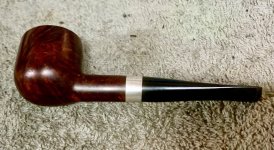
It just clicks off all the boxes.
First it’s a zesty, strong, flavorful smoker with lots of that Algerian Tabasco sauce whang to it. Yes, I do like that.
And it’s pretty.
And there’s this silver band hallmarked 1943 Birmingham
It’s not too big, not too little.
Modern pipe smokers don’t get to savor Algerian briar unless they cruise eBay looking for it.
Sterncrest intended that one to sell for $25.
Three little pits on final finish made it a no name Algerian.
But this $15 tonight on eBay Mastercraft Royal Ascot Supreme will also be a kick ass smoker, it will color the same dark red brown, it’s maybe not as pretty, not quite so full of whatever makes Algerian briar smoke uniquely, but it will be a good sumbitch, without doubt.
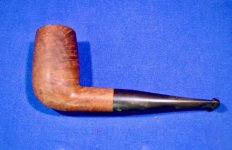
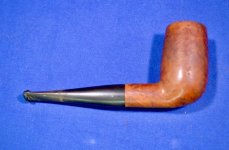
Once you get a taste for these, you’re like Daddy and the wine.
Last edited:
I’ve tried to do my own research on Algerian briar but all web results lead back to Briar Lee.
I’ve tried to do my own research on Algerian briar but all web results lead back to Briar Lee.
Alfred Dunhill built the White Spot Dunhill Shell briar brand using only ancient Algerian briar. He had to patent a way to use the soft, powdery stuff.
Xxxx
In producing the "shell", Dunhill used only Algerian briar, then in great abundance, because it had a softer character than the Italian briar used in the smooth "bruyere" finish. This soft character, in combination with the heat derived from Dunhill's unique oil curing process, led to an unusually deep and craggy sandblasted pipe. In the early years of production, Dunhill would not even stamp shape numbers on his "shell" pipes, since the shape of identically turned bowls varied so after curing and sandblasting.
A Tail of Two Briars - Pipedia
Xxxxxx
If I can only claim one thing remotely new about Algerian briar it’s this:
1. Ream out all cake. Every trace of black in the bowl. For whatever reason cake barely clings to Algerian briar. Get the bowl and rim brown again, it’s actually easy.
2. Remove all varnish and wax and all finish, leaving bare briar only. Scrub using soap and water and Brillo pads, they don’t melt. Get it clean.
3. Smoke while you rub beeswax on it.
Viola:
Before, as unboxed this afternoon
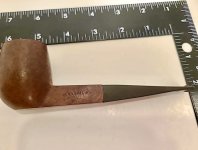
After two smokes, using beeswax.
Algerian briar was soft and it was an amazing insulator of heat, and something inside comes out to get trapped by wax, just like a meerschaum.
Beeswax gets soaked up like water inside a sponge in the briar. Carnauba is too hard, too high of melting point. Buff with a soft rag, no tools needed.
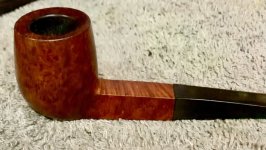
All Algerian briar will color.
Some quite dramatically.
This to date is the most extreme example.
Clean Benchmade Marxman
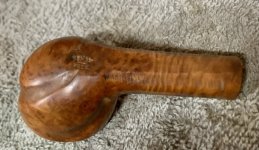
Four smokes later
Attachments
Last edited:
Is beeswax the sap you’re tasting?Alfred Dunhill built the White Spot Dunhill Shell briar brand using only ancient Algerian briar. He had to patent a way to use the soft, powdery stuff.
Xxxx
In producing the "shell", Dunhill used only Algerian briar, then in great abundance, because it had a softer character than the Italian briar used in the smooth "bruyere" finish. This soft character, in combination with the heat derived from Dunhill's unique oil curing process, led to an unusually deep and craggy sandblasted pipe. In the early years of production, Dunhill would not even stamp shape numbers on his "shell" pipes, since the shape of identically turned bowls varied so after curing and sandblasting.
A Tail of Two Briars - Pipedia
pipedia.org
Xxxxxx
If I can only claim one thing remotely new about Algerian briar it’s this:
1. Ream out all cake. Every trace of black in the bowl. For whatever reason cake barely clings to Algerian briar. Get the bowl and rim brown again, it’s actually easy.
2. Remove all varnish and wax and all finish, leaving bare briar only. Scrub using soap and water and Brillo pads, they don’t melt. Get it clean.
3. Smoke while you rub beeswax on it.
Viola:
Before, as unboxed this afternoon
View attachment 277090
After two smokes, using beeswax.
Algerian briar was soft and it was an amazing insulator of heat, and something inside comes out to get trapped by wax, just like a meerschaum.
Beeswax gets soaked up like water inside a sponge in the briar. Carnauba is too hard, too high of melting point.
View attachment 277091
Last edited:
Or, hear me out, what is causing the rapid coloring is the soft Algerian briar absorbing your beeswax, and not some Algerian super sap.Algerian briar was soft and it was an amazing insulator of heat, and something inside comes out to get trapped by wax
You should smoke one without waxing it, and see how long it takes to color.
Or, better yet, wax one without smoking it, and see if it colors right up all on it’s own!
Just a theory
Buying one now. Supposedly all the “good” Algerian briar was fire bombed in WW2. I find it hard to believe all the good stuff was bombed or foraged. Even if the new Algerian briar is only 70 years old, briar growth rings grow out. Does that make the briar denser or end up with more material to make a pipe?
Last edited:
- Status
- Not open for further replies.









